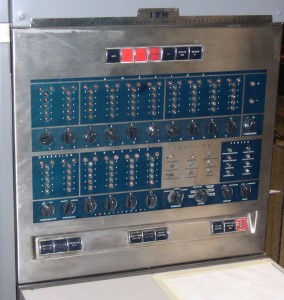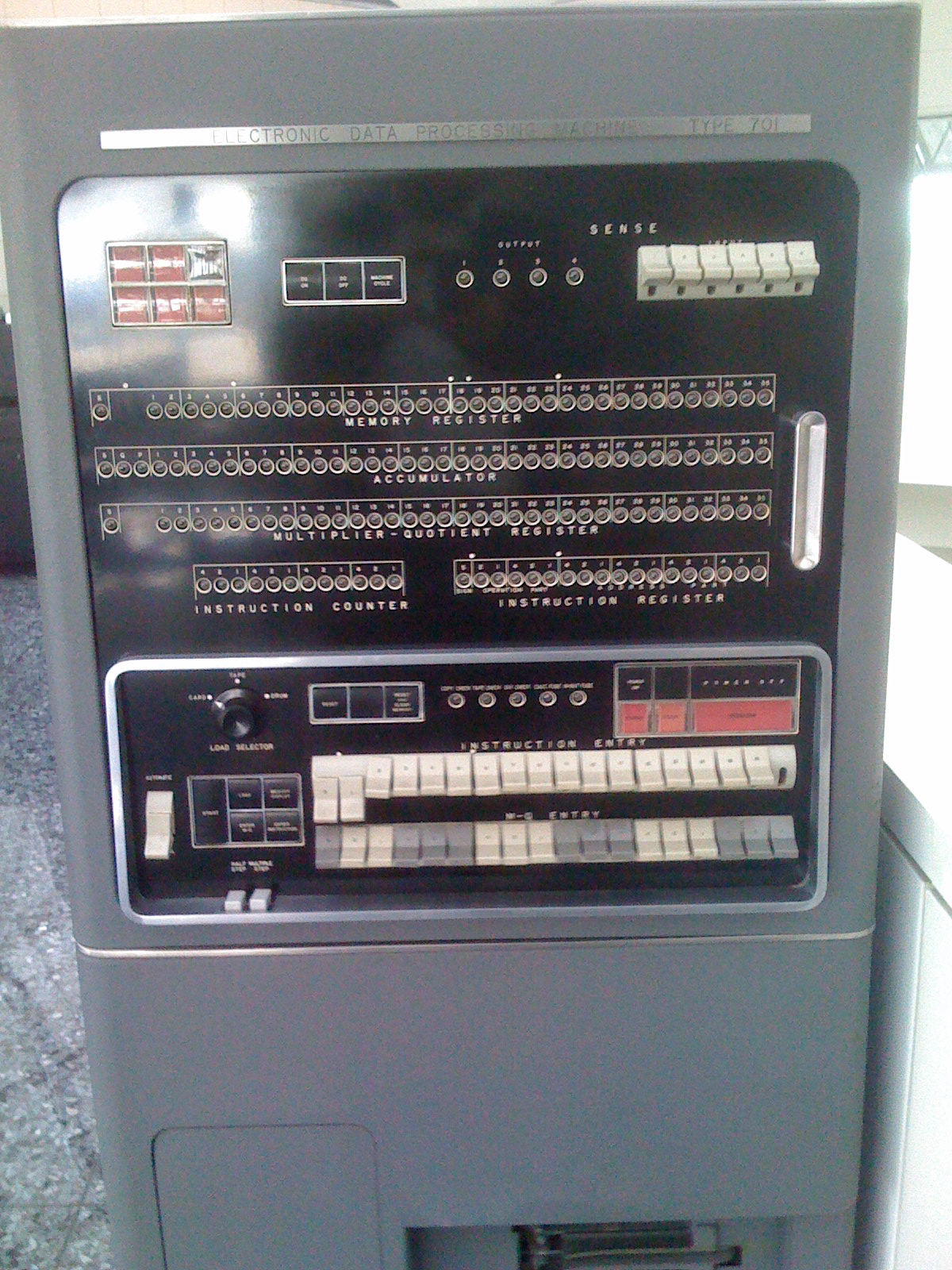|
IBM 1410
The IBM 1410, a member of the IBM 1400 series, was a decimal computer with variable word length that was announced by IBM on September 12, 1960 and marketed as a midrange business computer. It was withdrawn on March 30, 1970. Overview The 1410 was similar in design to the very popular IBM 1401, but it had one major difference. Addresses were five characters long and allowed a maximum memory of 80,000 characters, much larger than the 16,000 characters permitted by the 1401's three-character addresses. However, the 1410 could also be run in what was termed 1401 compatibility mode. On the 1410, this was accomplished in wired hardware - the machine literally turned into a 1401 with the flip of a switch. In addition, with care, it was possible to write source code in the Autocoder assembler language that could be used on either system, as nearly all 1401 instructions had exact 1410 equivalents, and had the same mnemonics. The later IBM 7010 used the same architecture as the 1410, bu ... [...More Info...] [...Related Items...] OR: [Wikipedia] [Google] [Baidu] |
IBM 1400 Series
The IBM 1400 series were second-generation (transistor) mid-range business decimal computers that IBM marketed in the early 1960s. The computers were offered to replace tabulating machines like the IBM 407. The 1400-series machines stored information in magnetic cores as variable-length character strings separated on the left by a special bit, called a "wordmark," and on the right by a "record mark." Arithmetic was performed digit-by-digit. Input and output support included punched card, magnetic tape, and high-speed line printers. Disk storage was also available. Many members of the series could be used as independent systems, as extensions to IBM punched-card equipment, or as auxiliary equipment to other computer systems. Some, however, were intended for specific applications or were economical only as independent systems. History The 1401, announced on October 5, 1959, was the first member of the IBM 1400 series. It was the first computer to deploy over 10,000 units. Th ... [...More Info...] [...Related Items...] OR: [Wikipedia] [Google] [Baidu] |
Decimal Computer
Decimal computers are computers which can represent numbers and addresses in decimal as well as providing instructions to operate on those numbers and addresses directly in decimal, without conversion to a pure binary representation. Some also had a variable wordlength, which enabled operations on numbers with a large number of digits. Early computers Early computers that were exclusively decimal include the ENIAC, IBM NORC, IBM 650, IBM 1620, IBM 7070, UNIVAC Solid State 80. In these machines, the basic unit of data was the decimal digit, encoded in one of several schemes, including binary-coded decimal (BCD), bi-quinary and two-out-of-five code. Except for the IBM 1620 and 1710, these machines used word addressing. When non-numeric characters were used in these machines, they were encoded as two decimal digits. Other early computers were character oriented, providing instructions for performing arithmetic on character strings of decimal numerals, using BCD or excess-3 (XS- ... [...More Info...] [...Related Items...] OR: [Wikipedia] [Google] [Baidu] |
Word (computer Architecture)
In computing, a word is the natural unit of data used by a particular processor design. A word is a fixed-sized datum handled as a unit by the instruction set or the hardware of the processor. The number of bits or digits in a word (the ''word size'', ''word width'', or ''word length'') is an important characteristic of any specific processor design or computer architecture. The size of a word is reflected in many aspects of a computer's structure and operation; the majority of the registers in a processor are usually word-sized and the largest datum that can be transferred to and from the working memory in a single operation is a word in many (not all) architectures. The largest possible address size, used to designate a location in memory, is typically a hardware word (here, "hardware word" means the full-sized natural word of the processor, as opposed to any other definition used). Documentation for older computers with fixed word size commonly states memory sizes in words ra ... [...More Info...] [...Related Items...] OR: [Wikipedia] [Google] [Baidu] |
IBM 1401
The IBM 1401 is a variable-wordlength decimal computer that was announced by IBM on October 5, 1959. The first member of the highly successful IBM 1400 series, it was aimed at replacing unit record equipment for processing data stored on punched cards and at providing peripheral services for larger computers. The 1401 is considered to be the Ford Model-T of the computer industry, because it was mass-produced and because of its sales volume. Over 12,000 units were produced and many were leased or resold after they were replaced with newer technology. The 1401 was withdrawn on February 8, 1971. History The 1401 project evolved from an IBM project named World Wide Accounting Machine (WWAM), which in turn was a reaction to the success of Bull Gamma 3 (fr). The 1401 was operated as an independent system, in conjunction with IBM punched card equipment, or as auxiliary equipment to IBM 700 or 7000 series systems. Monthly rental for 1401 configurations started at US$2,500 (wort ... [...More Info...] [...Related Items...] OR: [Wikipedia] [Google] [Baidu] |
Autocoder
Autocoder is any of a group of assembly language, assemblers for a number of IBM computers of the 1950s and 1960s. The first Autocoders appear to have been the earliest assemblers to provide a Macro (computer science), macro facility. Terminology Both ''autocoder'', and the unrelated ''autocode'', a term of the same era used in the UK for languages of a higher level, derive from the phrase ''automatic programming, automatic coding''. This referred generally to programs which eased the burden of producing the numeric machine language codes of programs. "Autocoding" is seen occasionally, and can refer to any kind of programming system. In some circles "autocoder" could be used generically to refer to what is now called a macro-assembler. History The first Autocoders were released in 1955 for the IBM 702, and in 1956 for the almost compatible IBM 705. They were designed by Roy Goldfinger who earlier had worked on New York University's (NYU) NYAP assembler. These machines were v ... [...More Info...] [...Related Items...] OR: [Wikipedia] [Google] [Baidu] |
IBM 700/7000 Series
The IBM 700/7000 series is a series of large-scale (Mainframe computer, mainframe) computer systems that were made by IBM through the 1950s and early 1960s. The series includes several different, incompatible processor architectures. The 700s use vacuum-tube logic and were made obsolete by the introduction of the transistor computer, transistorized 7000s. The 7000s, in turn, were eventually replaced with System/360, which was announced in 1964. However the 360/65, the first 360 powerful enough to replace 7000s, did not become available until November 1965. Early problems with OS/360 and the high cost of converting software kept many 7000s in service for years afterward. Architectures The IBM 700/7000 series has six completely different ways of storing data and instructions: *First scientific (36/18-bit words): IBM 701, 701 (Defense Calculator) *Later scientific (36-bit words, hardware floating-point): IBM 704, 704, IBM 709, 709, IBM 7040, 7040, IBM 7044, 7044, IBM 7090, 7090, I ... [...More Info...] [...Related Items...] OR: [Wikipedia] [Google] [Baidu] |
Variable Word Length Computers
{{Disambiguation ...
Variable may refer to: * Variable (computer science), a symbolic name associated with a value and whose associated value may be changed * Variable (mathematics), a symbol that represents a quantity in a mathematical expression, as used in many sciences * Variable (research), a logical set of attributes * Variable star, a type of astronomical star * "The Variable", an episode of the television series ''Lost'' See also * Variability (other) Variability is how spread out or closely clustered a set of data is. Variability may refer to: Biology *Genetic variability, a measure of the tendency of individual genotypes in a population to vary from one another *Heart rate variability, a phy ... [...More Info...] [...Related Items...] OR: [Wikipedia] [Google] [Baidu] |
.jpg)



